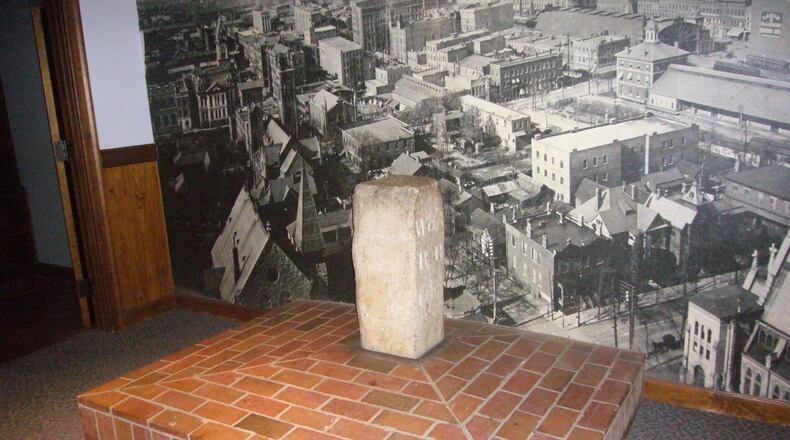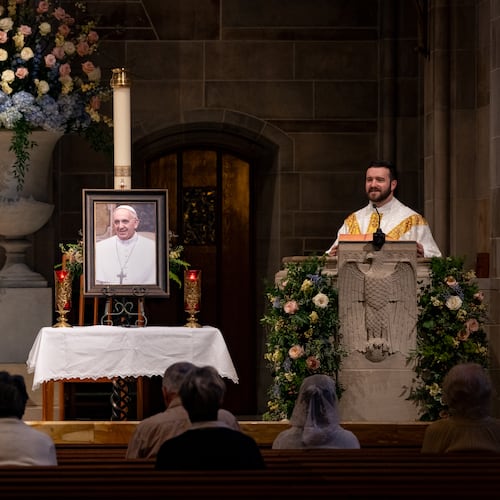The building housing the Zero Mile Post, one of Atlanta’s oldest historical landmarks, is slated for demolition sometime within six to 12 months, and the state agency handling its demolition is making no promises that the granite post will return to the position it’s held since 1850.
According to a statement provided to the AJC by the Georgia Building Authority, which owns the single-story building under the Central Avenue viaduct, the agency will “protect and preserve” the historic post but that its eventual position after the construction is “to be determined.” The GBA’s statement said that efforts will be made to “find a solution so the Zero Mile Post can be viewed by the general public.”
» RELATED: 10 things that were here before Atlanta
Currently the building that houses the post is closed to the public and sits behind a fence. Access to the landmark, which was named to the National Register of Historic Places, has been limited to appointments approved by the GBA.
According to the GBA’s statement, the building’s demolition is required in order to replace the Courtland Street and Central Avenue bridges. The 90 Central Avenue parking deck, which sits between the two bridges, will need additional entrance and exit options during the bridge replacement, according to the GBA, and the building housing the Zero Mile Post is blocking one of those entrance/exit ramps.
The replacement of the bridges is one of the projects covered by the Renew Atlanta T-SPLOST that was approved by voters in 2015.
A spokesperson for Renew Atlanta said five local, state and federal agencies, plus the public, will have a say in the fate of the post, and that the State Historic Preservation Office and the Federal Highway Administration will have final approval.
Renew Atlanta and the Georgia Building Authority, he said, have been working together on the project, and the building authority had “expressed an interest in finding a new, more accessible home” for the Zero Mile Post.
The building housing the Zero Mile Post was constructed in the late-1980s around the landmark as a passenger depot for a tourist line that went out to Stone Mountain, according to Jeff Morrison, an amateur historian who conducts walking tours beneath downtown’s network of viaducts. In more recent years the building was used as a police station until becoming vacant. Before its vacancy, police officers at the station made the post available to the public.
While some recent requests to access the post and building have been granted, others have not. In 2016, the Atlanta History Center used the site for a “Party with the Past” event. Earlier this year, a series of performances by the dance troupe gloATL that was to take place inside the building was moved to the space outside it after access was denied. The AJC was allowed to conduct a Facebook Live event at the site this week.
In 2003, a proposal to replace the Central Avenue viaduct included language that allowed the post to be moved from its original postition and “relocated to a point as close as is feasible and prudent to its original position.” That agreement, which at the time was reached by the Federal Highway Administration, the Georgia Department of Transportation and the Georgia Historic Preservation Office, is no longer in effect because the 2003 project was shelved, according to the spokesperson at Renew Atlanta.
The Zero Mile Post is a granite pillar about three feet tall that was erected in 1850 to mark the “terminus” of the Western & Atlantic Railroad. The railroad, which was surveyed in 1837 went into use in 1842, was commissioned by the Georgia Legislature as a way to bring rail into the state from Chattanooga. The W&A rail project was wildly successful and gave rise to a new city at the end of the line, which went by the names Terminus and Marthasville before settling on “Atlanta” in 1847. Other rail lines would later connect to the terminus and turn the city into a southeastern hub of transportation and commerce.
The Zero Mile Post was so important to the city that in 1874, the city limits were expanded and redrawn to form a circle with a radius of 1.5 miles out from the post. The post’s importance also lives on in the Atlanta United’s Golden Spike tradition, where a special guest star is invited to drive a large spike into the “ground” at Mercedes-Benz Stadium before each home game.
As the city has grown, several structures have been built around the Zero Mile Post. In 1853, a “car shed” was built at the corner of it. This structure was destroyed in 1864 by Gen. William Sherman’s Union troops and was replaced by Union Depot in 1871. Union Depot, in turn, was removed in 1929 when a network of elevated streets was built over the tracks, including the Central Avenue viaduct.
A public information session on the Central Avenue viaduct project is scheduled for May 17, from 6-8 p.m. at the Old Council Chambers (68 Mitchell Street).
About the Author
The Latest
Featured







